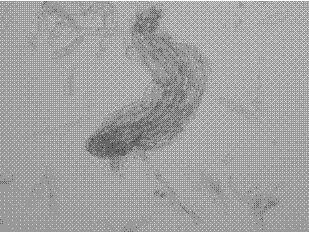Genetic transformation method of Chinese fir
A genetic transformation method, fir technology, applied in biochemical equipment and methods, horticultural methods, botanical equipment and methods, etc., can solve problems such as limitations, lack of transformation methods and regeneration systems, and achieve strong stress resistance and low cost Effect
- Summary
- Abstract
- Description
- Claims
- Application Information
AI Technical Summary
Problems solved by technology
Method used
Image
Examples
Embodiment 1
[0030] Example 1 Establishment of transforming receptors.
[0031] (1) Take about 5 mL of embryogenic callus cells of Chinese fir subcultured for 3 weeks, inoculate them into a 250 mL sterile Erlenmeyer flask, and gently tap the wall of the flask to disperse the cells. Microphotographs of embryogenic callus cells of Chinese fir figure 1 shown.
[0032] (2) Take 50mL Chinese fir liquid culture medium and add it into the Erlenmeyer flask, place the material in a constant temperature shaker at 23°C and 85r / min for shaking culture. Chinese fir liquid medium is DCR basic medium, supplemented with 10mg / L VC, 0.1-2.0mg / L GA, 2-5mg / L ABA, 0.5g / L CH, 30g / L maltose.
[0033] (3) Subculture once every 7 days, and it can be used for Agrobacterium infection 3 days after the third subculture (that is, from the third day of the fourth generation).
[0034] The receptor system in the process of plant gene transformation refers to the explants used for transformation through tissue culture ...
Embodiment 2
[0037] Example 2 Agrobacterium liquid preparation.
[0038] (1) Melt the EHA105 bacterial liquid with 35S:GUS gene (for transformation detection) and NPT-II gene (for screening) stored at -70°C on ice, dip a small amount of bacterial liquid with an inoculation loop, and inoculate Put it on the LB medium containing appropriate amount of antibiotics (kanamycin 50mg / L, streptomycin 30mg / L), and place it in a constant temperature incubator at 28°C for culture.
[0039] (2) After a single colony grows, use an inoculation loop to pick a single colony, inoculate it on the LB medium containing an appropriate amount of antibiotics (50 mg / L kanamycin, 30 mg / L streptomycin), and activate it again. Then they were cultured in a constant temperature incubator at 28°C.
[0040] (3) After a single colony grows, use a sterilized pipette tip to pick a single colony and inoculate it into a conical flask containing 10 mL of LB liquid medium with an appropriate amount of antibiotics, culture at 2...
Embodiment 3
[0047] Example 3 Infestation.
[0048] Shake the bacterial solution evenly, draw 3mL of the diluted bacterial solution and add it to the Chinese fir suspension cells (Example 1) that have been subcultured for 3 days. After standing for 1-3 minutes, place it on a constant temperature shaker at 23°C and 85r / min to continue shaking Cultivate, that is, co-cultivate.
[0049] Infection refers to the inoculation of engineered bacteria on the surface of the receptor material. The method is to add the prepared Agrobacterium liquid into the culture medium of the receptor material, soak for a certain period of time, and carry out co-cultivation. During the infection process, mastering the infection time will help reduce the possible pollution during the later cultivation process and reduce the poisonous effect of bacteria on plants. The dipping time is too short to allow enough Agrobacterium to attach to the explant wound, thereby reducing the frequency of genetic transformation. If t...
PUM
 Login to View More
Login to View More Abstract
Description
Claims
Application Information
 Login to View More
Login to View More - R&D
- Intellectual Property
- Life Sciences
- Materials
- Tech Scout
- Unparalleled Data Quality
- Higher Quality Content
- 60% Fewer Hallucinations
Browse by: Latest US Patents, China's latest patents, Technical Efficacy Thesaurus, Application Domain, Technology Topic, Popular Technical Reports.
© 2025 PatSnap. All rights reserved.Legal|Privacy policy|Modern Slavery Act Transparency Statement|Sitemap|About US| Contact US: help@patsnap.com



